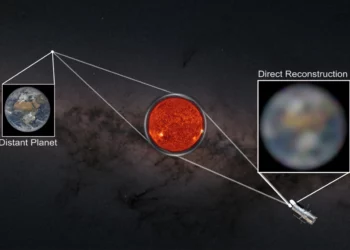
An international team of astronomers has detected complex organic molecules in the most distant galaxy to date (over 12 billion light years away) using NASA’s James Webb Space Telescope. Webb’s discovery of these molecules, which can be routinely found on Earth in smoke, soot and smog, shows its ability to help understand the complex chemistry of star birth even in the universe’s earliest periods.
The new findings challenge the old adage that where there’s smoke, there’s fire, at least as far as galaxies are concerned.
Because of its extreme distance, the light detected by astronomers began its journey when the universe was less than 1.5 billion years old, about 10% of its current age. The galaxy was first discovered by the National Science Foundation’s South Pole Telescope in 2013 and has since been studied by many observatories, including the Atacama Large Millimeter/submillimeter Array (ALMA) radio telescope and Hubble Space Telescope.
The discovery was made possible through the combined powers of Webb and fate in the form of a phenomenon called gravitational lensing. Lensing, originally predicted by Albert Einstein’s theory of relativity, happens when two galaxies are almost perfectly aligned from our point of view on Earth. The light from the background galaxy is stretched and magnified by the foreground galaxy into a ring-like shape, known as an Einstein ring.
“By combining Webb’s amazing capabilities with a natural ‘cosmic magnifying glass,’ we were able to see even more detail,” said lead author Justin Spilker, assistant professor in the Texas A&M Department of Physics and Astronomy and a member of the George P. and Cynthia Woods Mitchell Institute for Fundamental Physics and Astronomy.
“That level of magnification is actually what made us interested in looking at this galaxy with Webb in the first place, because it really lets us see all the rich details of a galaxy in the early universe that we could never do otherwise.”
The data from Webb found the telltale signature of large organic molecules akin to smog and smoke – building blocks of hydrocarbon emissions on Earth. These larger molecules are common in space and astronomers believe they indicate new star formation.
“Astronomers used to think they were a good sign that new stars were forming,” Spilker said. “Anywhere you saw these molecules, baby stars were also right there blazing away.”
The study results show that this idea might not exactly ring true in the early universe.
“Thanks to the high-definition images from Webb, we found a lot of regions with smoke but no star formation, and others with new stars forming but no smoke,” Spilker said.
The discovery is Webb’s first detection of the early universe’s complex molecules –- a milestone moment.
“These are early days for the Webb Telescope, so astronomers are excited to see all the new things it can do for us,” Spilker said. “Detecting smoke in a galaxy early in the history of the universe? Webb makes this look easy. Maybe we’ll even be able to find galaxies that are so young that complex molecules like these haven’t had time to form in the vacuum of space yet, so galaxies are all fire and no smoke. The only way to know for sure is to look at more galaxies, hopefully even further away than this one.”
The study was published in Nature.






